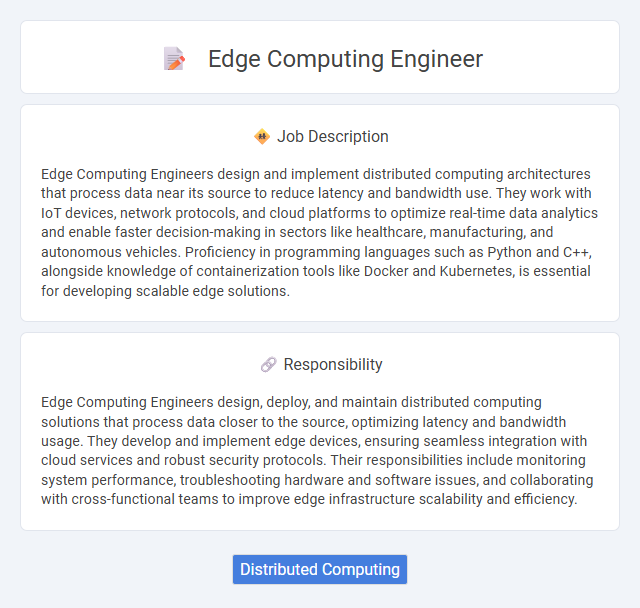
Edge Computing Engineers design and implement distributed computing architectures that process data near its source to reduce latency and bandwidth use. They work with IoT devices, network protocols, and cloud platforms to optimize real-time data analytics and enable faster decision-making in sectors like healthcare, manufacturing, and autonomous vehicles. Proficiency in programming languages such as Python and C++, alongside knowledge of containerization tools like Docker and Kubernetes, is essential for developing scalable edge solutions.
Individuals comfortable with fast-paced, technology-driven environments will likely thrive as Edge Computing Engineers. Those who possess strong problem-solving skills and adaptability may find the role well-suited to their abilities, especially if they enjoy working on cutting-edge infrastructure and decentralized systems. People preferring routine tasks or minimal collaboration might find this position less compatible with their work style.
Qualification
An Edge Computing Engineer must have expertise in distributed computing, network protocols, and IoT architectures, with proficiency in programming languages such as Python, C++, or Java. Advanced knowledge of cloud platforms like AWS, Azure, or Google Cloud, combined with experience in containerization tools such as Docker and Kubernetes, is essential. Strong analytical skills and a background in data processing, real-time systems, and security practices are critical for optimizing edge infrastructure performance.
Responsibility
Edge Computing Engineers design, deploy, and maintain distributed computing solutions that process data closer to the source, optimizing latency and bandwidth usage. They develop and implement edge devices, ensuring seamless integration with cloud services and robust security protocols. Their responsibilities include monitoring system performance, troubleshooting hardware and software issues, and collaborating with cross-functional teams to improve edge infrastructure scalability and efficiency.
Benefit
Edge Computing Engineer roles likely offer significant benefits including enhanced expertise in decentralized systems and edge infrastructure, increasing career marketability. Professionals in this field probably experience opportunities to work on cutting-edge technologies that optimize real-time data processing and reduce latency. The position often provides the chance to contribute to innovative solutions across industries such as IoT, autonomous vehicles, and smart cities, likely leading to strong professional growth and competitive compensation.
Challenge
Edge Computing Engineer roles likely present challenges related to managing limited resources and ensuring low-latency processing near data sources. The complexity of integrating edge devices with cloud infrastructure may require innovative problem-solving and continuous adaptation to evolving technologies. Engineers might often face difficulties in maintaining security and scalability in distributed environments.
Career Advancement
Edge Computing Engineers gain expertise in distributed computing systems and real-time data processing, enabling them to design scalable, low-latency solutions for IoT and 5G networks. Mastery in edge AI, container orchestration, and security protocols enhances their value, opening pathways to senior engineering roles, architecture positions, and lead project management in cutting-edge technology firms. Continuous skill development in cloud-edge integration and automation tools significantly accelerates career progression and leadership opportunities in the evolving tech landscape.
Key Terms
Distributed Computing
Edge Computing Engineers specialize in designing and implementing distributed computing architectures that process data closer to the source, reducing latency and bandwidth usage. They develop scalable edge solutions integrating IoT devices, cloud services, and real-time analytics to enhance performance and security across decentralized networks. Expertise in containerization, microservices, and distributed ledger technologies is critical for optimizing edge computing infrastructures.
 kuljobs.com
kuljobs.com